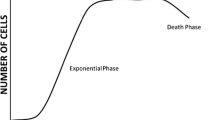Abstract
Hybridoma cells usually grow to fairly low cell densities in batch cultures (1–3×106 cells/ml). The reason for this is either that essential nutritional components of the medium are consumed, or that the cells produce some kind of inhibitory or toxic metabolite. This investigation presents evidence for the latter. Spent medium from cultures of hybridoma cells did not support growth of cells at lower cell densities (1–3×105 cells/ml). The ability to support cell growth could not be restored by adding additional serum, energy sources (glucose, pyruvate) or L-glutamine. Furthermore, the consumption of amino acids could not account for this growth inhibition. On the contrary, the spent medium contained a substance that inhibited cell growth. This substance or metabolite was found in a fraction eluted from a gel filtration column when spent medium was applied to the column. This substance was found in the spent medium from all hybridoma and myeloma cell lines that were tested. The molecular weight of the substance was about 5 kD. Spent medium from two hybridoma cell lines also contained a substance that was eluted in the same fraction as albumin (67 kD). It is likely that this (or these) substance(s) is responsible for the growth limitation in hybridoma cell cultures.
Similar content being viewed by others
Abbreviations
- PBS:
-
phosphate buffered saline
References
Butler M and Jenkins H (1989) Nutritional aspects of the growth of animal cells in culture. J. Biotechnol 12: 97–110.
Caroll WL, Thielemans K, Dilley J and Levy R (1986) Mouse x human heterohybridomas as fusion partners with human B cell tumors. J. Immunol. Methods 89: 61–72.
Comer MJ, Kearns MJ, Wahl J, Munster M Lorenz T, Szperalski B, Koch S, Behrendt U and Brunner H (1990) Industrial production of monoclonal antibodies and therapeutic proteins by dialysis fermentation. Cytotechnology 3: 295–299.
Glacken MW, Fleischaker RJ and Sinskey AJ (1986) Reduction of waste product excretion via nutrient control: Possible strategies for maximizing product and cell yields on serum in cultures of mammalian cells. Biotechnol. Bioeng. 27: 1376–1389.
Handa-Corrigan A (1988) Large scale in vitro hybridoma culture: Current status. Biotechnology 6: 784–786.
Kidwell WR (1989) Filtering out inhibition. Biotechnology 7: 462–463.
Kvalhein G, Fodstad Ø, Phil A, Nustad K, Pharo A, Ugelstad J and Funderud S (1987) Elimination of B-lymphoma cells from human bone marrow: Model experiments using monodisperse magnetic particles coated with primary monoclonal antibodies. Cancer res. 47: 846–851.
Lund A, Hellemann AL and Vartdal F (1988) Rapid isolation of K88+Escherichia coli by using immunomagnetic particles. J. Clin. Microbiol. 26: 2572–2575.
Mosmann T (1983) Rapid colorimetric assay for cellular growth and survival: Application to proliferation and cytotoxicity assays. J. Immunol Methods 65: 55–63.
Newland M, Greenfield PF and Reid S (1990) Hybridoma growth limitations: The role of energy metabolism and ammonia production. Cytotechnology 3: 215–229.
Rønning ØW and Christophersen (in press) An ELISA-method using magnetic beads as solid phase for rapid quantitation of mouse and human immunoglobulins. Hybridoma.
Rønning ØW and Schartum M (1990) Removal of inhibitory factors from hybridoma cell culture by gel filtration. In: Spier RE, Griffiths JB and Meignier B (eds.) Production of biologicals from animal cell culture. (pp. 218–225) Butterworth-Heinemann Ltd.
Schumpp B and Schlaeger E-J (1989) Physiological studies of high cell density cultures of different cell lines. In: Spier RE, Griffiths JB, Stephenne J and Crooy PJ (eds.) Advances in animal cell biology and technology for bioprocesses. (pp. 224–229) Butterworths & Co Ltd.
Schlaeger E-J and Schumpp B (1989) Studies on mammalian cell growth in suspension culture. In: Spier RE, Griffiths JB, Stephenne J and Crooy PJ (eds.) Advances in animal cell biology and technology for bioprocesses. (pp. 386–397) Butterworths & Co Ltd.
Sjøgren-Jansson E and Jeansson S (1985) Large-scale production of monoclonal antibodies in dialysis tubings. J. Immunol. Methods 84: 359–364.
Thorpe JS, Murdin AD and Spier RE (1987) Waste products affecting hybridoma culture. 194. Am. Chem. Soc. (abstr).
Wagner R, Ryll T, Krafft H and Lehmann (1988) Variation of amino acid concentration in the medium of HU β-IFN and HU IL-2 producing cell lines. Cytotechnology 1: 145–150.
Author information
Authors and Affiliations
Rights and permissions
About this article
Cite this article
Rønning, Ø.W., Schartum, M., Winsnes, A. et al. Growth limitation in hybridoma cell cultures: The role of inhibitory or toxic metabolites. Cytotechnology 7, 15–24 (1991). https://doi.org/10.1007/BF00135634
Received:
Accepted:
Issue Date:
DOI: https://doi.org/10.1007/BF00135634




